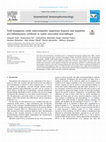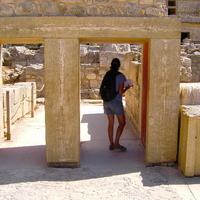Papers by Mahuya Sengupta

Asian Journal of Pharmaceutical and Clinical Research, Jan 7, 2019
Objective: This study aims to assess the effects of the aqueous extract of Hydrocotyle javanica (... more Objective: This study aims to assess the effects of the aqueous extract of Hydrocotyle javanica (HJ) in ameliorating mercury-induced neurobehavioral toxicity. Methods: For the study, 36 adult male Swiss albino mice of 25-30 g in weight were taken. They were equally divided into six groups. Group I was treated with distilled water, Group II was treated with mercuric chloride (1.5 mg/kg), Group III was treated with HJ extract low dose (100 mg/kg), Group IV was treated with HJ extract high dose (200 mg/kg), Group V was treated with mercuric chloride plus HJ extract low dose, and Group VI was treated with mercuric chloride plus TB extract high dose. In all the groups, the doses were administered orally through oral gavage tube and the treatment lasted for 14 days. The behavioral effects evaluated were locomotor activity in the open field test, immobility in forced swimming test and anxiety in elevated plus maze test, spatial learning ability and memory in the Morris water maze test. The present study showed that mercury exposure significantly decreased the locomotor activity (p<0.001), number of annulus crossovers (p<0.001), number of open arm entries (p<0.01), time spent in open arms (p<0.001), and increased escape latency (p<0.01), path length (p<0.001), and immobility (p<0.001) in mice. The aqueous extract of HJ significantly alleviated the neurotoxic effects of mercury. The aqueous extract of HJ showed to increase the locomotor activity (p<0.01), number of annulus crossovers (p<0.001), number of open arm entries (p<0.05), and time spent in open arms (p<0.05), which was decreased in mercury-exposed mice. The HJ extract also showed to decrease the immobility (p<0.001), escape latency (p<0.05), and path length (p<0.001) in mercury-exposed mice. The result of the study shows that neurobehavioral changes induced by mercuric chloride were significantly reversed by the aqueous extract of HJ. Thus, base on the present study, it is concluded that HJ is effective in ameliorating the neurobehavioral deficits induced by mercury.
Assam University Journal of Science and Technology, Sep 8, 2010
Effect of Tinospora cordi/olia extracts on immunostimulatory functions in carbon tetrachloride (C... more Effect of Tinospora cordi/olia extracts on immunostimulatory functions in carbon tetrachloride (CCI) intoxicated Swiss albino mice is reported here. Administration of CC1 4 (O.05mllkg bw for 7 days) caused immunosuppression as evident from splenic macrophage functions viz., phagocytosis, cell adhesion and myeloperoxidase release. Treatment with T. cordi/olia extract (10 mglkg bw for 15 days) in CC1 4 intoxicated mice ameliorated the immunosuppressive effect ofCC!., since wefound a Significant increase in the cellular functions of murine splenic macrophages following T. cordi/olia treatment. Our findings suggest that T. cordi/olia may have a therapeutic role against immune toxicity.
Cellular & Molecular Immunology, May 24, 2018
Asian pacific Journal of Tropical Biomedicine, Jun 1, 2011

ACS Omega
Cellular internalization of plasmonic metal nanostructured materials has recently become a requis... more Cellular internalization of plasmonic metal nanostructured materials has recently become a requisite for biomedical engineering of several intracellular processes that could foster an extensive paradigm to perform desired functions in the living cells. While numerous anisotropic metal nanostructures can be employed to pursue the specific functions, their incorporation becomes restricted due to morphological specificity to be engulfed in the cells. Due to recent advent in the self-assembly strategies, individual gold nanospheres could be interdigitated to one-dimensional plasmonic polymers and undergo subsequent laser-induced photothermal reshaping to rod-like nanostructures. The salient feature of biological significance is merely the variation of particle size within the polymers that engenders a dramatic impact on the radiative and nonradiative properties expressed in the scale of Faraday number (Fa) and Joule number (J0), respectively, as a function of the aspect ratio (α) of the nanorods. The effect on the nonradiative properties augments designing of nanoscale thermometry essential for photothermal applications in living cells. The conception of the colloidal dispersion has been extended to the cellular environment in a mice model; the selective accumulation of the nanostructures in the cells could provide an invading relationship between plasmonic characteristics, temperature distribution, and the biological issues. The critical correlation between optical and thermal characteristics toward biomedical manipulation from both theoretical and experimental perspectives could augment a milestone toward the progress of modern medical sciences.
International Journal For Multidisciplinary Research
In recent times, cases of infectious and malignant diseases are increasing in an exponential mann... more In recent times, cases of infectious and malignant diseases are increasing in an exponential manner. The treatments to these diseases face drawbacks of specificity and high costs. Due to this, many patients seek alternative or complementary methods of treatment. Ethnomedicine is the first and foremost choice in this regard. However, due to cultural beliefs, no proper documentation with scientific validation is available. The present study intended to validate the potentiality of the ethnomedicinal plants of the Sonowal Kachari community of Assam, quantitatively and qualitatively along with a few bioactivity studies of oxidative stress and antioxidant defenses in a murine immune model.

The testis though recognized as an immuneprivileged organ, there are a number of immunocompetent ... more The testis though recognized as an immuneprivileged organ, there are a number of immunocompetent cells like macrophages, neutrophils and monocytes within the testicular interstitial compartment which give evidence of testicular immune response. Among them, macrophage population is the largest one and is known to influence the function of the neighboring Leydig cells. Testicular macrophages are the largest population of immune cells in the rodent testes. Exposure to cadmium chloride in-vitro is known to inhibit the testicular macrophage functions. But the extent of effect or the mechanism thereof is not well elucidated. The present study examined the extent of immunomodulatory effect in murine testes after in-vitro exposure to cadmium. To elucidate the immunomodulatory effects of cadmium, cell function studies such as morphological alteration, phagocytosis, intracellular killing mechanism, DNA fragmentation, enzyme activity (nitric oxide, myeloperoxidase synthase) and proinflammatory...

ChemMedChem, 2021
We report the influence of Fe3O4 nanoparticles (NPs) on porphyrins in the development of photosen... more We report the influence of Fe3O4 nanoparticles (NPs) on porphyrins in the development of photosensitizers (PSs) for efficient photodynamic therapy (PDT) and possible post‐PDT responses for inflicting cancer cell death. Except for Au, most metal‐based nanomaterials are unsuitable for clinical applications. The US Food and Drug Administration and other agencies have approved Feraheme and a few other iron oxide NPs for clinical use, paving the way for novel biocompatible immunoprotective superparamagnetic iron oxide nanohybrids to be developed as nanotherapeutics. A water‐soluble nanohybrid, referred to here as E‐NP, comprising superparamagnetic Fe3O4 NPs functionalised with tripyridyl porphyrin PS was introduced through a rigid 4‐carboxyphenyl linker. As a PDT agent, the efficacy of E‐NP toward the AGS cancer cell line showed enhanced photosensitising ability as determined through in vitro photobiological assays. The cellular uptake of E‐NPs by AGS cells led to apoptosis by upregulati...

Aquatic Toxicology, 2021
Cadmium (Cd) with no known functional role in any life-form has myriad of harmful effects. The pr... more Cadmium (Cd) with no known functional role in any life-form has myriad of harmful effects. The present study was designed to elucidate the mechanism of Cd-induced oxystress generation and its impact on antioxidant and apoptosis signaling pathways in head kidney macrophage (HKM) of Channa punctatus Bloch. Fish were sampled and acclimatized with one group treated with cadmium chloride (CdCl2) (1.96 mg/L) and another as untreated control group, both kept under observation for 7 days. Exposure to Cd caused ultrastructural changes along with reduced head kidney somatic index (HKSI). Significantly increased levels of reactive oxygen species (ROS), respiratory burst activity, lipid peroxidation, DNA fragmentation and superoxide dismutase were found in the HKM from the treated group as compared to control. In contrast, antioxidant enzymes like catalase and reduced glutathione activity decreased in the Cd exposed group. The suppressed antioxidant activity was further confirmed and corroborated from the altered expression of Kelch-like ECH-associated protein 1 (Keap1) and nuclear factor erythroid 2-related factor 2 (Nrf2) genes, the major player of antioxidant pathway. Cd induced alteration in Nrf2-Keap1 signaling pathway was also validated by the diminished levels of Nrf2 dependent expression of protein like heme oxygenase-1 (HO-1). The flow cytometry analysis supported the event of apoptosis in Cd exposed group as compared to control, which was further confirmed by the upregulated expression of caspase-3, caspase-8, caspase-9, TNF-α and p53 genes from the real-time gene expression study. In addition, altered protein level of cytochrome C validates the incidence of apoptosis. Altogether, our results demonstrate that exposure to Cd caused oxidative stress in HKM of Channa punctatus Bloch. by compromising the antioxidant enzyme activities via the down regulation of expression of genes related to antioxidant signaling pathway besides encouraging apoptosis via both mitochondrial and death receptor pathway.

BioNanoScience, 2020
Recent advances in the nanosciences have revolutionized the diagnosis and treatment of diseases l... more Recent advances in the nanosciences have revolutionized the diagnosis and treatment of diseases like cancers. Arsenic(III) trioxide, best known as a toxic agent, is routinely used in treating different types of leukemia. Besides its application as a chemotherapeutic drug for treating acute promyelocytic leukemia, several attempts have been made to use arsenic trioxide (ATO) against solid tumors. This is however, restricted because of the rapid renal clearance and dose-associated side effects of ATO. This work aims to address these limitations of ATO in chemotherapy by synthesizing biocompatible human serum albumin coated arsenic trioxide nanoparticles (HSA-ATONPs) by an alkaline hydrothermal process, taking sodium arsenate as a precursor. Compared with bulk ATO, these are found to have better cytotoxicity as indicated by an in vitro study with the cancer cell line MCF7. As envisaged by transmission electron microscopy, canonical signs of apoptosis were observed in the MCF 7 cells treated with HSA-ATONPs, confirmed by Annexin V-FITC staining. The study thus, reports an augmentation of the chemotherapeutic potential of arsenic trioxide in its nanoparticulate form with its surface functionalization of human serum albumin.

Journal of Environmental Pathology, Toxicology and Oncology, 2017
The effect of smokeless tobacco (gutkha) was investigated by treating male and female Swiss Albin... more The effect of smokeless tobacco (gutkha) was investigated by treating male and female Swiss Albino mice with an aqueous extract of smokeless tobacco (AEST). AEST was administered at a dose of 25 mg kg -1 body weight per day for different time periods (6, 12, 16, and 24 weeks), and control animals were provided only drinking water without AEST for the same period. Control and AEST-treated mice were observed for different oxidative stress parameters, nitric oxide (NO) release, and myeloperoxidase (MPO) release, and they were evaluated for alterations in tumor suppressor and DNA repair responses in the liver and spleen. Both male and female mice treated with AEST showed significant increase in lipid peroxidation, protein carbonylation, and NO and MPO release in the liver and spleen compared to age-and gender-matched controls. The significant decline in tumor suppressor p53 protein levels, likely mediated by concomitantly upregulated levels of Mdm2, was observed. We also observed a significant decline in the levels of DNA repair proteins Brca2 and Ape-1 compared to the respective controls. Thus, AEST induces oxidative stress, inflammation, and significantly lowers tumor suppressor and DNA repair responses. These factors may work in conjunction to increase the risk for certain diseases, including cancer.

International immunopharmacology, 2018
The tumor microenvironment, essentially hypoxic, is sustained by the hypoxia inducing factor (HIF... more The tumor microenvironment, essentially hypoxic, is sustained by the hypoxia inducing factor (HIF), released from the pro-tumorigenic tumor associated macrophages (TAMs), functionally identical to the M2 phenotype macrophages. Stability of HIF mainly depends on molecular oxygen and an iron-dependent enzyme prolyl hydroxylase, while its activity may be inhibited by high levels of reactive oxygen species and nitric oxide. The present work showcases a novel approach utilizing the anti-tumorigenic potential of a gold-manganese oxide nanocomposite material in the tumor microenvironment that affects tumor hypoxia, exploring the possibility of restoring the immunoregulatory nature of TAMs from their pro-tumorigenic state. Along with the biochemical markers, ELISA and FACS analyses have also confirmed the potential of these nanoparticles in reverting back the M2 phenotype of TAMs to their classically activated M1 phenotype.

Pathology oncology research : POR, Jan 13, 2018
Anti-diabetic drugs are an important group of therapeutics used worldwide. Different anti-diabeti... more Anti-diabetic drugs are an important group of therapeutics used worldwide. Different anti-diabetic drugs lower blood glucose level by different mechanisms. In recent years, numerous investigations have been performed based on both comparative and cohort studies, in order to establish the relationship between anti-diabetic pharmacotherapy and cancer incidence as well as mortality due to cancer. Some anti-diabetic drugs have been found to exhibit anti-cancer activity while others might increase the risk for cancer. The underlying cause for this disparity is likely to be the varying mechanisms of action of these drugs in controlling blood glucose level. This review discusses the various carcinogenic and/or anti-cancer effects of commonly used anti-diabetic drugs. The information is vital in view of the fact that diabetes mellitus is a commonly occurring disease with a rising incidence rate.
RSC Advances, 2016
Reduced magnetism of Fe3O4–Mn3O4 nanocomposites synthesised by alkaline hydrolysis has been explo... more Reduced magnetism of Fe3O4–Mn3O4 nanocomposites synthesised by alkaline hydrolysis has been explored for in vitro cytotoxicity studies on splenic macrophages.

International Immunopharmacology, 2016
Diagnosis of cancer and photothermal therapy using optoelectronic properties of noble metal nanop... more Diagnosis of cancer and photothermal therapy using optoelectronic properties of noble metal nanoparticles (NPs) has established a new therapeutic approach for treating cancer. Here we address the intrinsic properties of noble metal NPs (gold and silver) as well as the mechanism of their potential antitumor activity. For this, the study addresses the functional characterization of tumor associated macrophages (TAMs) isolated from murine fibrosarcoma induced by a chemical carcinogen, 3-methylcholanthrene (MCA). We have previously shown antitumor activity of both gold nanoparticles (AuNPs) and silver nanoparticle (AgNPs) in vivo in a murine fibrosarcoma model. In the present study, it has been seen that AuNPs and AgNPs modulate the reactive oxygen species (ROS) and reactive nitrogen species (RNS) production, suppressing the antioxidant system of cells (TAMs). Moreover, the antioxidant-mimetic action of these NPs maintain the ROS and RNS levels in TAMs which act as second messengers to activate the proinflammatory signaling cascades. Thus, while there is a downregulation of tumor necrosis factor-α (TNF-α) and Interleukin-10 (IL-10) in the TAMs, the proinflammatory cytokine Interleukin-12 (IL-12) is upregulated resulting in a polarization of TAMs from M2 (anti-inflammatory) to M1 (pro-inflammatory) nature.
European Journal of Medicinal Chemistry, 2015
1. A novel water soluble oxovanadium(IV) complex of cefuroxime antibiotic have been prepared. 2. ... more 1. A novel water soluble oxovanadium(IV) complex of cefuroxime antibiotic have been prepared. 2. The cefuroxime and its oxovanadium complex exhibited effective antioxidant and antibacterial activity. 3. The potential use of vanadium-cefuroxime complex as an immunosuppressant reveals from phagocytosis, myeloperoxidase release and cytokine assay.

Asian Pacific Journal of Tropical Medicine, 2014
To investigate the antibacterial effect of Curcuma longa (C. longa), Zingiber officinale (Z. offi... more To investigate the antibacterial effect of Curcuma longa (C. longa), Zingiber officinale (Z. officinale) and Tinospora cordifolia (T. cordifolia) against Staphylococcus aureus, Pseudomonas aeruginosa, Klebsiella pneumoniae, Escherichia coli, Bacillus subtilis and Proteus mirabilis of clinical origin. Methods: The antimicrobial efficacy of said medicinal plants and establishment of multidrug resistant character of these bacteria were carried out using disc diffusion, minimum inhibitory concentration (MIC) and minimum bactericidal concentration (MBC) methods. The results of MIC and MBC showed that these clinical bacterial isolates were phenotypically multidrug resistant against standard antibiotics (>500 µg/mL). Compared to standard antibiotics, C. longa, Z. officinale and T. cordifolia were more effective in killing these microbes as evident from MIC and MBC values (5 to 125 µg/mL). Moreover, C. longa had highest antibacterial efficacy compared to Z. officinale and T. cordifolia. The result thus obtained suggests that bioactive principles of these plants can be used particularly against these multidrug resistant bacteria of clinical origin.
Cellular & molecular immunology, Jan 24, 2018









Uploads
Papers by Mahuya Sengupta